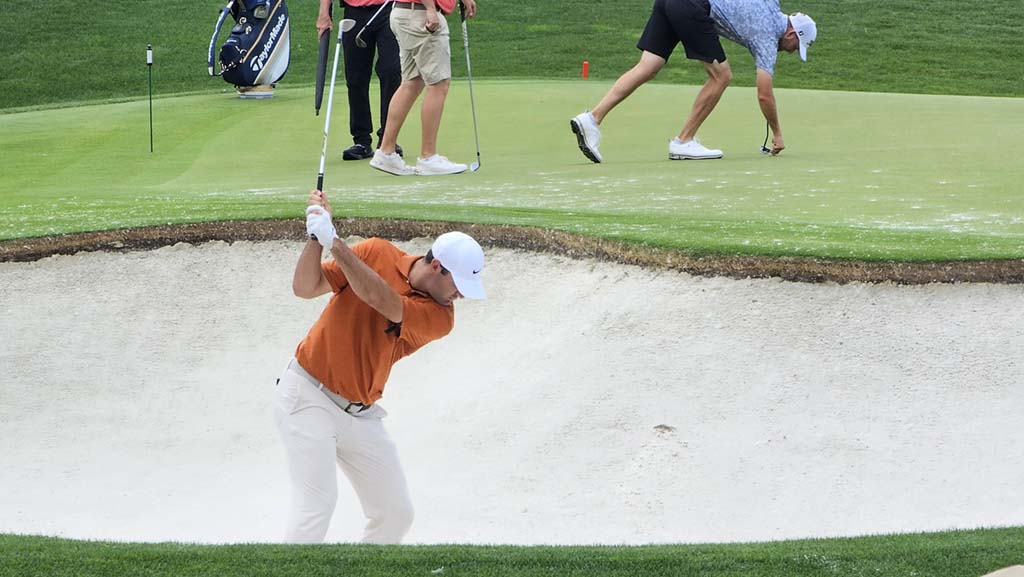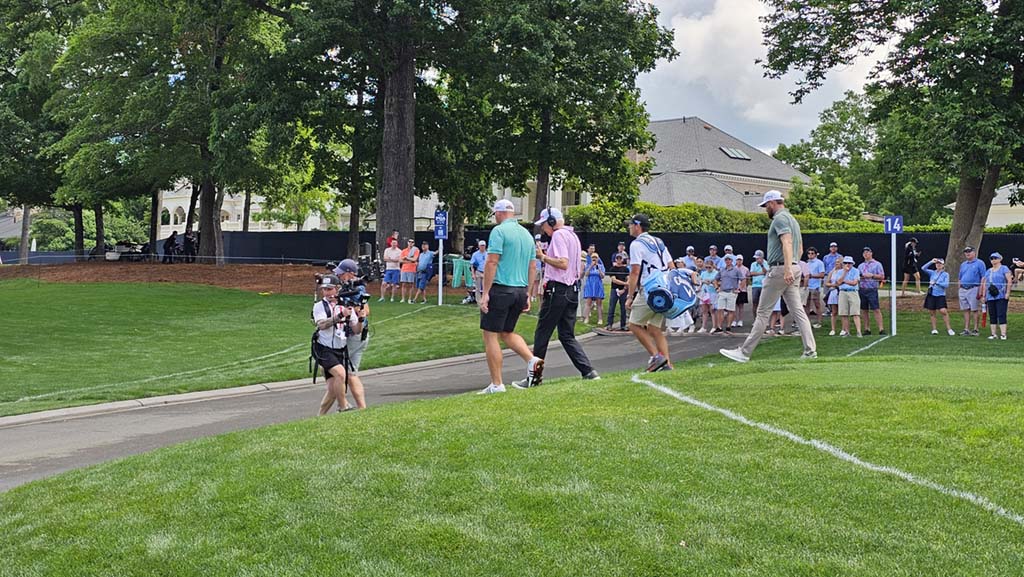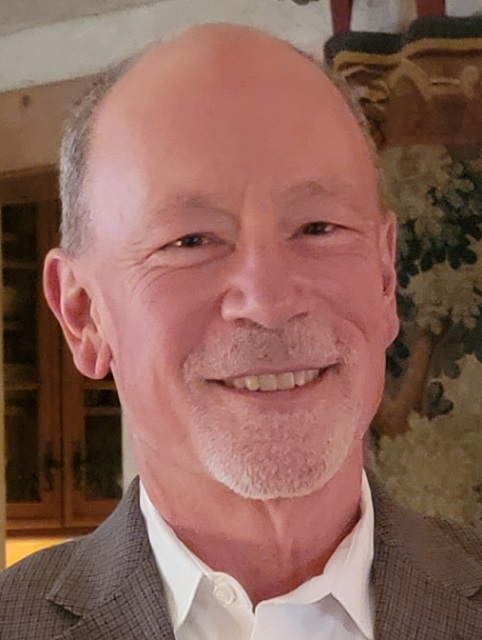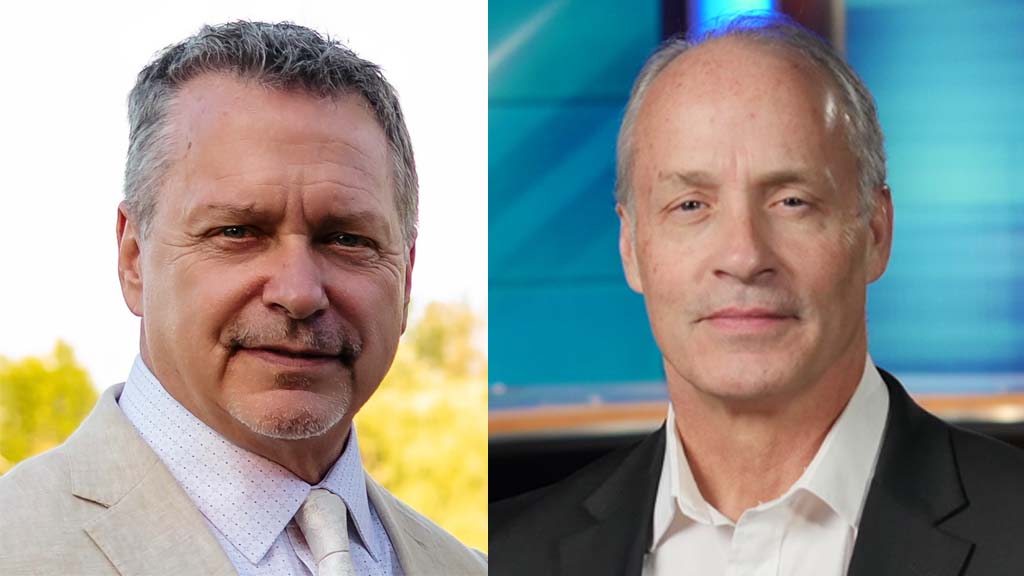CBS Sports Adds Innovative AR to Massive PGA Championship Coverage
14th-hole augmented reality deployment is just one of the innovations in use

(Editor’s note: CBS Sports coverage of the PGA Championship began May 15 and wraps up May 18. Interviews for this story were conducted on-site May 14.)
CHARLOTTE, N.C.—To fans and golfers at the 14th hole here at Quail Hollow, nothing appears to be out of the ordinary for one of the four majors.
Not so for the viewers at home enjoying CBS Sports coverage of the PGA Championship.
The broadcaster, working with a handful of technology vendors, has created “an immersive tee box of the future,” leveraging artificial intelligence (AI), augmented reality (AR) graphics, 5G wireless connectivity, a remotely controlled robotic camera and tracking data system, Jason Cohen, senior vice president of remote technical operations for CBS Sports and CBS Sports Network, said.
“We are bringing the tee box to life in a more immersive virtual manner so we can show headshots of the group that’s about to hit,” Cohen said. “We can do a virtual display of the hole with a trail of the ball in this virtual map, and we can use the shot link data to create other metrics and information about how the golfer has been playing that course or how the hole has been played in general by other golfers in the field.”
The immersive tee box isn’t the only innovative technology the broadcaster is bringing to the tournament. Ball tracing from drones, first deployed last summer, is making its PGA Championship debut. Two new miniature POV 4K cameras embedded in the bunker at the 18th hole will enable CBS to zoom in to capture “nice, tight shots” showing the grains of sand as the ball is being hit without losing any resolution for the 1080p HDR production, Cohen said.
Other familiar technologies, including three FlyCams suspended overhead from two wires over different parts of the course and practice range, two drones, the blimp and the jibs, are contributing their unique perspectives to the overall production. “These other camera technologies are not just eye candy,” he said. “They really help with coverage.”
The professional video industry's #1 source for news, trends and product and tech information. Sign up below.
AR Deep Dive
What set the immersive tee box in motion was a desire to use all available data in a new, more effective way. “There’s a lot of information, a lot of data and a lot of analytics at our disposal that always don’t make the screen at the same time,” Cohen said.
Forming a technology partnership with T-Mobile, Cohen’s team began to reimagine coverage from the tee box that would be more futuristic and innovative.
The setup relies on a combination of technologies from a variety of vendors. All video and tracking data for the immersive experience is being transported via a T-Mobile 5G wireless network, which “goes into the private network cores located on premise,” said Scott Jacka, senior director of technology development strategy at T-Mobile. From the core, a fiber connection transmits the video and data to the CBS broadcast compound.
“The signal is lightning-quick,” Cohen said. “It’s almost as fast as the fiber, which is almost mathematically hard to believe.”

High above the tee box in a trace tower, a Robovision robotic camera, with a Mo-Sys Sony P50 robotic camera alongside it, is capturing the video and tracking data needed for the virtual presentation. Alston Elliot (AE) Live, which acquired Silver Spoon Animation in 2023, is providing the augmented reality engine, including hardware, software and personnel, in the broadcast compound.
Finally, a virtual window adjacent to the golfer in the tee box is displaying a virtual representation of the 14th hole created by Animation Research Labs (ARL) to show viewers how that golfer is playing that hole as he tees off.
CBS is deploying a roaming Steadicam-mounted Sony camera tech stack, including the Sony PDT-FP1 portable data transmitter, which transmits footage of the golfers as they leave the 13th hole and enter the 14th. T-Mobile 5G is used to transport the HEVC-encoded video from the rig at 25Mbps.
“It’s a full end-to-end 5G experience from the moment the golfers release 13 to the moment that ball lands wherever the drivable ball goes on the 14th hole,” Cohen said.
When not capturing players leaving the 13th on their way to the 14th hole, the roaming camera is also being used for “a walk and talk” with players as they walk from the 14th to the 18th holes, Grant Castle, senior vice president of systems realization at T-Mobile, said.
Size, Scope and Storms
The PGA Championship is a massive remote production. CBS has assembled 24 mobile production trucks, including units from NEP, Game Creek and F&F Productions, six trucks playing supporting roles and some 700 technicians and engineers, production personnel, managers and vendor partners for its coverage.
More than 125 cameras are strategically placed to capture every shot over the four-day tournament. “We try to anticipate and think about what the course is offering us that’s unique from year to year because we’re going to a different location each year.
“We take every hole and dissect it from the tee to the green, thinking about which angle we can shoot from and what different types of camera technologies allow us to capture all those unique angles,” Cohen said.

He points to the FlyCams as an example. One travels along the two-wire system across the large lake on the back nine from the 14th green to nearly the 18th green. “That’s an exciting camera technology,” Cohen said. “It’s got a fluctuating line where it can dip down to almost skim the water and then come back up.”
Another, the Sparrow FlyCam, is a miniature version that travels on the wire system from a tower on the 18th through a grandstand window. “These are not just bells and whistles,” he said. “They really help out with our coverage as players tap out on those various greens.”
Setup for the coverage began in mid-April with early work on the broadcast compound. Production trucks were on-site and parked by May 7. In the days leading up to the championship, severe thunderstorms struck the Charlotte area.
“A lot of the cameras were bagged and covered,” Cohen said. “A lot of them were not even deployed. But that schedule that we built takes into account an unforeseen situation. It allows us to still be in a position where today, which is an enormous day before air, we are doing a full rehearsal of every camera and every technology. The production teams are in their trucks right now getting set for the first golfers from tomorrow morning.”
Phil Kurz is a contributing editor to TV Tech. He has written about TV and video technology for more than 30 years and served as editor of three leading industry magazines. He earned a Bachelor of Journalism and a Master’s Degree in Journalism from the University of Missouri-Columbia School of Journalism.

